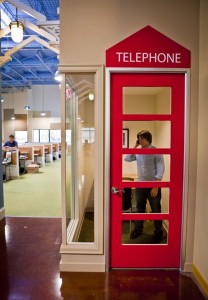Open plan offices have gained popularity over the past few years for several reasons: they're cheaper and more space-efficient, they offer more opportunities for workers to collaborate with each other, and they're often more pleasing to look at. (Easier to fit in giant stuffed animal mascots or Google-esque playroom furniture when you have room to play with.)
So let's say you decide to take the plunge and move your company to an open office plan. How can you make the transition as smooth as possible for your employees, many of whom will like the old way simply because it is the old way? How can you help people see the benefits of the new design, and make the best use of what it offers?
1. Talk to your workers.

First and foremost, take the time to actually explain the new office plan, and why it was chosen. Many workers will suspect that it's simply an attempt to save a few bucks. Don't deny that it will be more cost-efficient. That's a good way to look like you're trying to con your workers. Instead, enumerate problems inherent in the old design, and explain how this plan will fix them.
Cummins Inc. recently introduced a collaborative workspace to their offices in Columbus, Indiana. Their old design was cubicle-based — and low on natural light.
"It was really dark," said Vanessa E. Cunningham, Cummins Collaborative Workplace planning leader.
Opening up the office "turned around what was really an undesirable area," she said.
2. Ask before you plan.

This brings us to another point: It's worth polling your workers to see what's bothering them about their workspace, before you plan a redesign. Even if what you get back doesn't really help you — "We would like solid gold cubicles containing only video game consoles. Also, unlimited Diet Coke." — at least you'll know what you're dealing with before you sink a lot of money into furniture.
Plus, workers often have the best ideas of what works and what doesn't in terms of space allotment and office equipment. It's much more difficult to guess from a distance whether or not something's working. Asking ahead is basically the office planning equivalent of the carpenter's maxim, "Measure twice, cut once."
3. Provide privacy.

The single biggest complaint companies hear after they move from cubicles to an open office plan is that people miss having private space. Make sure people have somewhere private and secure to store their personal items. Lockers work well for this, especially if your vision of the new office doesn't include assigned work areas.
And no matter how collaborative your business is, you'll want to make sure there are some private conference rooms. They'll come in handy when you need to have meetings that aren't appropriate for all ears, and they'll enable folks to talk to one another informally in groups without filling the office with a constant din. Finally, it's hard to feel totally comfortable in a work environment if you have to sneak into the bathroom to make a doctor's appointment. Providing a little private space will make everyone feel more at ease and work better, too.
Images: HermanMiller.com, Ideaguides.com, Washingtonpost.com





